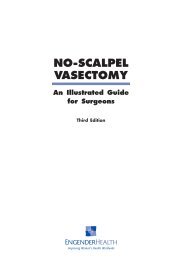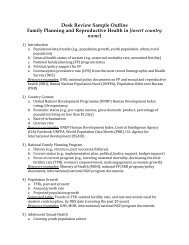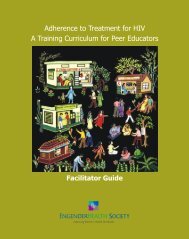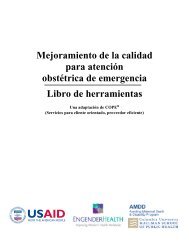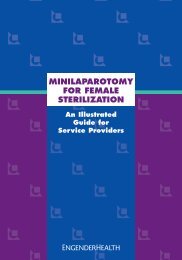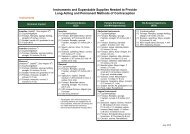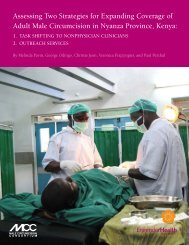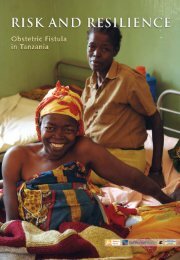COPE® FOR MALE CIRCUMCISION SERVICES - EngenderHealth
COPE® FOR MALE CIRCUMCISION SERVICES - EngenderHealth
COPE® FOR MALE CIRCUMCISION SERVICES - EngenderHealth
Create successful ePaper yourself
Turn your PDF publications into a flip-book with our unique Google optimized e-Paper software.
■ Plain gauze swabs (10 10×10 cm for procedure, 5 10×10 cm for dressing)<br />
COPE for Male Circumcision Services<br />
■ Petroleum jelly–impregnated gauze (5×5 cm or 5×10 cm) (“tulle gras”) and sticking<br />
plaster<br />
■ 15 ml 1% or 2% plain lidocaine (without adrenaline) anesthetic solution in single-use<br />
syringe with 21-gauge needle<br />
■ 18” chromic gut 4-0 sutures with 13 mm to 19 mm 3/8 circle reverse-cutting needle<br />
■ Sterile marker pen<br />
■ Condoms (both male and female)<br />
10. Do health care staff do each of the following<br />
■ Inform the client or parents/guardians of minor children about the procedure and what<br />
is involved, including potential risks (e.g., pain, swelling, bleeding, infection, etc.)<br />
■ Explain that the procedure will be done under local anesthesia and that the client will<br />
be free to talk with the providers during the procedure<br />
■ Provide services to all clients or parents/guardians of minor children free of stigma and<br />
discrimination (i.e., they do not judge clients, deny full quality care, or refuse to provide<br />
service)<br />
■ Actively encourage clients or parents/guardians of minor children to talk and ask<br />
questions<br />
■ Listen attentively and respectfully to clients or parents/guardians of minor children and<br />
respond to their questions<br />
■ Discuss clients’ HIV prevention needs and concerns<br />
■ Assist clients or parents/guardians of minor children in making an informed decision<br />
about MC<br />
■ Ask clients or parents/guardians of minor children whether the information was<br />
explained clearly and what further questions or suggestions they might have<br />
11. Does your health care setting have a mechanism for identifying and contacting clients<br />
who do not return for necessary follow-up after provision of MC services<br />
12. Are health care providers readily available for clients when there is a complication or<br />
when they come back with some health concerns about their circumcision (See p. 11 for<br />
examples of possible postoperative or intraoperative complications.)<br />
13. Is your health care setting engaged in efforts to reduce HIV-related stigma and<br />
discrimination, both internally and in the surrounding community, to help reduce<br />
potential barriers to HIV services, including MC<br />
14. Before ending any client visit, do staff ask clients if they need any other services<br />
15. Do the staff in your health care setting routinely book clients for follow-up after the MC<br />
procedure<br />
16. Do all staff, including the guards, know where and when the MC services are available in<br />
your health care setting<br />
<strong>EngenderHealth</strong> 23



